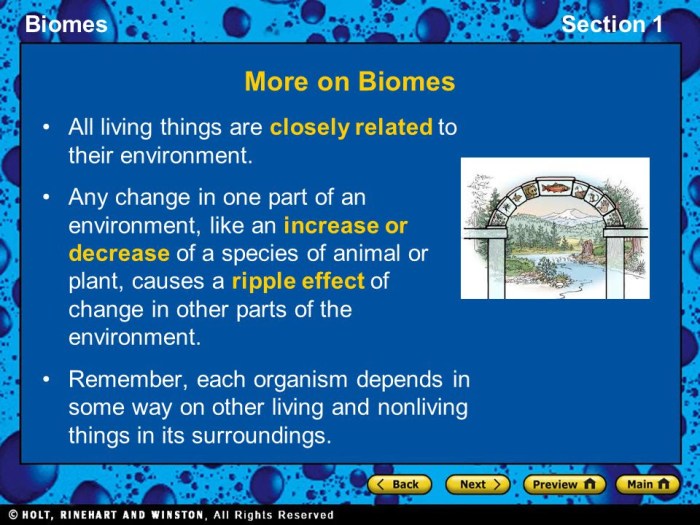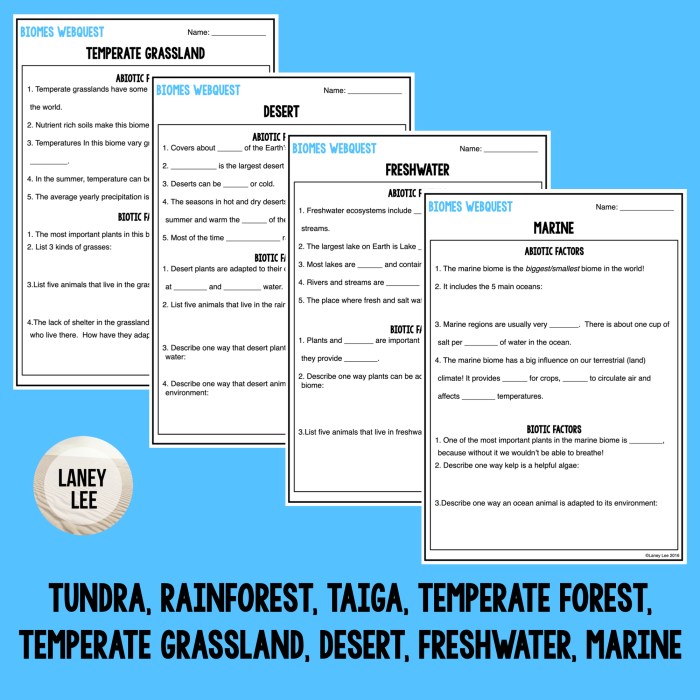Embark on an immersive exploration of aquatic biomes with the Aquatic Biomes Webquest Answer Key. Delve into the depths of these fascinating ecosystems, unraveling their intricate characteristics, ecological dynamics, and the diverse adaptations of their inhabitants.
This comprehensive guide provides a panoramic view of aquatic biomes, encompassing their abiotic and biotic factors, the remarkable adaptations of organisms within them, and the pressing threats they face. Through this journey, you will gain a profound understanding of the vital role these ecosystems play in sustaining biodiversity and the health of our planet.
Definition of Aquatic Biomes
Aquatic biomes encompass all water-based ecosystems on Earth, from the smallest ponds to the vast oceans. These ecosystems are characterized by their unique physical and chemical properties, such as temperature, salinity, and light availability, which shape the communities of organisms that inhabit them.
Types of Aquatic Biomes
- Freshwater Biomes:These biomes include lakes, rivers, streams, and wetlands. They are characterized by low salinity and can be further classified based on factors such as water flow rate and nutrient availability.
- Marine Biomes:These biomes include oceans, seas, and estuaries. They are characterized by high salinity and can be further classified based on factors such as depth, temperature, and nutrient availability.
- Intertidal Biomes:These biomes occur in the areas where the land and water meet, such as rocky shores and sandy beaches. They are characterized by fluctuating water levels and high salinity during high tide.
Factors Influencing Aquatic Biomes

Abiotic Factors
- Temperature:Water temperature affects the metabolic rates and distribution of organisms in aquatic biomes. Warmer waters support a greater diversity of life than colder waters.
- Light:Light penetration is essential for photosynthesis, which is the primary energy source for most aquatic organisms. The availability of light can vary with depth, water clarity, and turbidity.
- Salinity:Salinity refers to the concentration of dissolved salts in water. Different organisms have varying tolerances to salinity, which can affect their distribution and abundance.
- pH:pH is a measure of the acidity or alkalinity of water. It can influence the availability of nutrients and the survival of organisms.
Biotic Factors
- Competition:Competition for resources such as food, space, and mates can shape the distribution and abundance of organisms in aquatic biomes.
- Predation:Predation is a major force in aquatic ecosystems, as predators regulate the populations of prey species and influence the overall structure of the community.
- Symbiosis:Symbiotic relationships, such as mutualism and commensalism, can provide advantages to organisms in aquatic biomes.
Adaptations of Organisms in Aquatic Biomes

Adaptations for Freshwater Biomes
- Osmoregulation:Freshwater organisms have adaptations to regulate their water and ion balance, as freshwater is hypotonic to their body fluids.
- Respiratory Adaptations:Freshwater organisms have respiratory adaptations, such as gills or specialized respiratory surfaces, to extract oxygen from water.
- Temperature Tolerance:Freshwater organisms have adaptations to tolerate seasonal temperature fluctuations and cold winter conditions.
Adaptations for Marine Biomes
- Osmoregulation:Marine organisms have adaptations to regulate their water and ion balance, as seawater is hypertonic to their body fluids.
- Salt Tolerance:Marine organisms have evolved physiological adaptations to tolerate the high salinity of seawater.
- Pressure Tolerance:Deep-sea organisms have adaptations to withstand the immense water pressure found in their habitats.
Adaptations for Intertidal Biomes
- Tidal Adaptations:Intertidal organisms have adaptations to withstand the changing water levels and fluctuating salinity of their habitats.
- Desiccation Tolerance:Intertidal organisms have adaptations to prevent water loss and survive exposure to air during low tide.
- Wave Resistance:Intertidal organisms have adaptations, such as strong holdfasts or streamlined bodies, to withstand the force of waves.
Threats to Aquatic Biomes
Pollution
- Nutrient Pollution:Excess nutrients, such as nitrogen and phosphorus, from agricultural runoff and wastewater can cause algal blooms and disrupt aquatic ecosystems.
- Toxic Chemicals:Industrial pollutants, such as heavy metals and pesticides, can accumulate in aquatic organisms and have harmful effects on their health and reproduction.
- Plastic Pollution:Plastic debris can entangle or be ingested by aquatic organisms, causing physical damage and health problems.
Habitat Loss, Aquatic biomes webquest answer key
- Dam Construction:Dams can fragment aquatic ecosystems, block fish migration, and alter water flow patterns.
- Deforestation:Clearing forests near aquatic ecosystems can lead to erosion and increased sedimentation, which can harm aquatic organisms.
- Coastal Development:Coastal development can destroy or degrade important aquatic habitats, such as coral reefs and seagrass beds.
Climate Change
- Rising Sea Levels:Rising sea levels due to climate change can inundate coastal habitats and displace aquatic organisms.
- Ocean Acidification:Increased levels of carbon dioxide in the atmosphere lead to ocean acidification, which can harm marine organisms that build shells or skeletons.
- Warming Waters:Warming waters due to climate change can shift the distribution of aquatic organisms and disrupt their life cycles.
Conservation of Aquatic Biomes: Aquatic Biomes Webquest Answer Key

Aquatic biomes are essential for biodiversity and ecosystem services, such as water purification, flood control, and recreation. Conservation efforts are crucial to protect and restore these ecosystems.
Strategies for Conservation
- Reduce Pollution:Implementing measures to reduce nutrient pollution, toxic chemical discharge, and plastic waste can protect aquatic ecosystems.
- Protect Habitats:Establishing protected areas, such as marine sanctuaries and national parks, can safeguard aquatic habitats from human activities.
- Restore Ecosystems:Restoring degraded aquatic ecosystems, such as replanting mangroves or creating artificial reefs, can enhance biodiversity and ecosystem services.
- Climate Change Mitigation:Taking action to mitigate climate change, such as reducing greenhouse gas emissions, is essential for the long-term protection of aquatic biomes.
Frequently Asked Questions
What are the major types of aquatic biomes?
Aquatic biomes are broadly classified into two main types: freshwater biomes and marine biomes. Freshwater biomes include lakes, rivers, streams, and wetlands, while marine biomes encompass oceans, estuaries, and coral reefs.
How do abiotic factors influence aquatic biomes?
Abiotic factors such as temperature, light availability, salinity, and dissolved oxygen levels play a crucial role in shaping aquatic ecosystems. These factors determine the distribution and abundance of organisms within a biome.
What are some adaptations of organisms living in aquatic biomes?
Organisms in aquatic biomes have evolved diverse adaptations to survive in their specific environments. These adaptations include streamlined body shapes for reducing drag, specialized respiratory systems for extracting oxygen from water, and buoyancy mechanisms for maintaining stability.